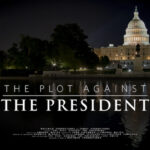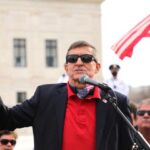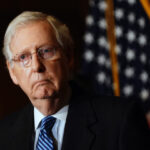By Jeff Carlson and Hans Mahncke
News analysis
In Oct. 2016, Wikileaks released a little-noticed email exchange involving Clinton communications director Jennifer Palmieri and Democratic strategist Joel Johnson. The exchange, which was dated Feb. 26, 2016, revealed the existence of a Clinton campaign Swift Boat project—a political term used for smear campaigns—aimed at then-presidential candidate Donald Trump. At the time, the email was largely ignored but it has recently gained new relevance through disclosures in court filings by special counsel John Durham.
It appears that the Clinton campaign’s plans revolved around two primary prongs directed at Trump. The first and better known element of that project involved Fusion GPS and Trump-dossier author and former MI6 spy Christopher Steele. The other element involves the efforts of Clinton campaign lawyer Michael Sussmann and his use of data exploited by technology executive Rodney Joffe and a team of IT operatives. Last year, Sussmann came to prominence when he was indicted by Durham for lying to the FBI in connection with his role in passing Joffe’s data to the FBI.
The two-pronged strategy began to take shape in the Spring of 2016, and those parallel plans would ultimately merge together at the end of July 2016, just two days before the FBI opened its investigation into the Trump campaign.
Trump Swift Boat Project
On Feb. 26, 2016, Palmieri was asked in an email by former Bill Clinton adviser Joel Johnson, “Who was in charge of the Trump swift boat project?” Palmieri sarcastically replied: “Gee. Thanks, Joel. We thought we could half-ass it. Let’s discuss.”
It is not known what steps were taken by the Clinton campaign in the two months that followed the email exchange. At the time, Trump had not yet won the Republican nomination. However, by mid-April 2016, it had become increasingly clear that Trump would be Clinton’s opponent in the general election.
On April 19, 2016, Trump hired Paul Manafort as his convention manager. Manafort, who was known to be a former adviser to Ukraine’s deposed president Viktor Yanukovich, would become Trump’s campaign manager two months later.
Trump’s primary wins and the hiring of Manafort coincided with a decision in late April by the Clinton campaign to hire Fusion GPS, a firm of political operatives run by former Wall Street Journal staffer Glenn Simpson.
Around this same time, on April 28, 2016, Amy Dacey, CEO of the Democratic National Committee (DNC), alerted Sussmann, who is also a cyber-security specialist, to the possible hack of the DNC’s computer network. In turn, Sussmann contacted Shawn Henry of Crowdstrike, an IT firm specializing in cybersecurity. It is not known why Dacey’s first point of contact was Sussmann and not an IT firm.
On May 3, 2016, Trump won the Indiana primary and became the presumptive nominee of the Republican Party.
That same day, Ukrainian-American Democratic operative Alexandra Chalupa emailed the DNC and claimed that she intended to share sensitive info about Paul Manafort “offline” including “a big Trump component…that will hit in [sic] next few weeks.” Manafort would leave the Trump campaign a few months later after The New York Times claimed that Manafort’s name had appeared on a handwritten ledger in Ukraine in connection with secret cash payments. The ledger was later said to have been fabricated.
Plan Set in Motion Right After Trump Became Presumptive Nominee
According to court filings from Durham, on May 4, 2016, the day after Trump became the Republican Party’s presumptive nominee, a cyber group working through Sussmann and Joffe began compiling and curating data that would later be used to create the false appearance of a link between the Trump Organization and the Russian Alfa Bank. That alleged link would later be used by the Clinton campaign to push the narrative that Trump had ties to the Kremlin. Notably, the data compilation was completed on July 29, 2016, the same day that Clinton operatives from both prongs of her planned attack on Trump met in Washington.
In mid-May 2016, shortly after Sussmann’s cyber group started mining data on Trump, Fusion GPS hired Steele to write the Steele dossier. As Simpson later recounted in his book “Crime in Progress,” he “told Steele that Fusion had been investigating Trump for about eight months on behalf of an unnamed client. That work had ended, but a new client had come along that had deep pockets.” That client was the Clinton campaign.
Steele tasked his primary sub-source, Igor Danchenko, to compile derogatory stories about Trump that could be used in the dossier. Danchenko was dispatched to Moscow in mid-June where he spent time gossiping with old friends over drinks. Those friends were then made into unwitting sources for the dossier. These same individuals have since come forward as part of Alfa Bank’s ongoing defamation lawsuit against Simpson and Fusion GPS to testify under oath that they did not have any information on Trump and never spoke to Danchenko about Trump.
As Durham has disclosed in court filings, the true source for several of the dossier’s stories, including a story about Manafort, was Clinton operative Charles Dolan. Danchenko concealed this fact from the FBI, according to Durham. In Nov. 2021, Durham indicted Danchenko for lying to the FBI about his sources.
While Dolan, according to Durham, gave Danchenko stories that appeared in the dossier and helped Danchenko obtain a visa (presumably to remain in the United States), not much is known about his wider role in Clinton’s Swift Boat project. Dolan and the Clintons go back many decades, with Dolan having served on Bill Clinton’s presidential exploratory committee, as well as Clinton’s Virginia state chairman in his 1992 and 1996 campaigns. Dolan also served as an adviser to Hillary Clinton’s first presidential run in 2008. Notably, Dolan was a senior consultant for the Russian government from 2006 to 2014.
Steele’s first dossier report—which not only contained the notorious pee tape allegation, but also seeded the collusion narrative—was issued on June 20, 2016.
After Steele had compiled his initial reports he began to reach out to the FBI through Michael Gaeta, an FBI agent and assistant legal attaché at the U.S. Embassy in Rome. Gaeta, who was Steele’s FBI handler, had known Steele since 2010. At Steele’s request, the two men met in London on July 5, 2016. In order to make this trip, Gaeta sought permission from Victoria Nuland, then-Assistant Secretary of State. At some point in early July, either Steele or Gaeta passed Steele’s early dossier reports to Nuland. Nuland later said these documents were passed on to both the leadership of the FBI and then-Secretary of State John Kerry.
Gaeta, who would receive additional reports from Steele in mid-July and August 2016, emailed an FBI supervisor on July 28, 2016, noting that Steele had personally informed him that Steele’s reports may already be circulating at a ‘high level’ in Washington, D.C.”
The Clinton Campaign Invokes Russian Interference
On July 24, 2016, Clinton campaign manager Robbie Mook publicly suggested for the first time that Russia was somehow helping Trump. Mook claimed in an interview with CNN’s Jake Tapper that the Russian government was behind the release of a trove of DNC emails. Those emails showed, in part, that senior DNC officials had been undermining Democratic candidate Sen. Bernie Sanders.
Mook refused to address the Sanders allegations, instead telling Tapper that “experts are now saying the Russians are releasing these emails for the purpose of actually helping Donald Trump.” Mook claimed that “this isn’t my assertion. There are a number of experts that are asserting this. … That is what experts are telling us.” But Mook failed to address who these so-called “experts” might be. Nor did he explain the source of his supposed information.
Two days after Mook had invoked Russia, on July 26, 2016, Clinton won the Democratic presidential nomination. According to documents released by Director of National Intelligence John Ratcliffe on Oct. 6, 2020, on the same day as her nomination win, Clinton allegedly approved a proposal from “one of her foreign policy advisors” to “vilify Donald Trump by stirring up a scandal claiming interference by Russian security forces”—the Trump–Russia collusion smear. That foreign policy adviser is rumored to be the current national security adviser, Jake Sullivan, who at the time held the title of senior foreign policy adviser for the Clinton campaign.
Immediately following the alleged approval from Clinton, Steele hastily produced his undated memo 95—written on or about July 27, 2016—which alleged “a well-developed conspiracy of cooperation” between Trump associates and the Kremlin. Steele’s memo, which echoed the basis of the Clinton campaign’s plan, also claimed that an unknown Trump associate had admitted that the Kremlin was behind the release of the DNC emails.
On July 28, 2016, CIA director John Brennan briefed President Barack Obama on Clinton’s July 26th plan—including her campaign’s intention to tie Trump to Russian election interference “as a means of distracting the public from her use of a private email server.” FBI Director James Comey may also have been at this meeting as Brennan’s now declassified hand-written notes state that “JC” was at this meeting.
The Two Prongs Converge
The day after Brennan briefed Obama, the twin prongs of the Clinton campaign’s smear campaign—Sussmann’s work with Joffe and Fusion’s work with Steele—merged. In a meeting that took place in Perkins Coie offices on July 29, 2016, Sussmann and fellow Perkins attorney Marc Elias met with Fusion GPS principals, including owner Glenn Simpson and Steele, according to the Durham indictment.
According to Durham’s indictment of Sussmann, the timing of this meeting at Perkins coincides perfectly with the completion of Sussmann’s and Joffe’s data compilation on July 29, 2016.
Steele had previously told a British court that Sussmann informed him at this meeting of the Alfa Bank allegations, stating, “I’m very clear is [sic] that the first person that ever mentioned the Trump server issue, Alfa server issue, was Mr. Sussman [sic].” Steele also testified that he was instructed by Fusion GPS co-founder Simpson to include this information in one of his own dossier reports. Steele, who repeatedly wrote tailor-made reports for Fusion GPS, mentioned Alfa Bank in a report on Sept. 14, 2016.
Following the meeting at Perkins Coie’s offices, Steele prepared a new memo the next day for his dossier, which falsely alleged an eight-year Russian effort to cultivate Trump.
The close timing of these events, particularly Brennan’s briefing to Obama, are significant because they came only days before the FBI officially opened its Crossfire Hurricane investigation into ties between the Trump campaign and Russia.
That FBI investigation was allegedly opened on July 31, 2016, after the Australian ambassador in London, Alexander Downer, gave the U.S. embassy a tip about Trump foreign policy adviser George Papadopoulos.
According to Downer, he and Papadopolous had met in May 2016 when Papadopoulos supposedly made a suggestion of a suggestion that Russia might have derogatory information on Hillary Clinton that might help Trump. That rumor was already known at the time and had been shared by Judge Andrew Napolitano on Fox News on May 9, 2016, the day before Downer met Papadopoulos.
Downer later confirmed in a 2019 interview on Australian TV that Papadopoulos said nothing out of the ordinary. But despite the flimsiness of Papadopoulos’s statements, the FBI used Downer’s info as a pretext to open a formal investigation into the Trump campaign.
In the weeks that followed the FBI’s opening of their Crossfire Hurricane investigation, CIA Director Brennan would take a number of actions that appear to have been intended to actively reinforce the basic premise behind Clinton’s plan—that Russia was interfering in the election to help Trump.
Brennan Pushes Trump–Russia Collusion Despite Knowledge of Clinton’s Plans to Smear Trump
The twin prongs of the attack against Trump had now been merged by the heads of the intelligence community into a single, unified spear that incorporated government agencies and government action.
One of the first actions from Brennan took place on Aug. 4, 2016, when Brennan suddenly warned Russia’s FSB head Alexander Bortnikov not to engage in U.S. election interference. Bortnikov reportedly strongly denied any Russian involvement but “said he would take Brennan’s concern to Russian President Vladimir Putin.” Brennan later claimed that he “was the first U.S. official to brace Russia on this issue.”
According to Brennan’s May 23, 2017, congressional testimony, he then began a series of briefings to the Congressional Gang of Eight—the majority and minority leaders of each chamber of Congress as well as the chairmen and ranking minority members of the Intelligence Committees. Brennan testified that, “in consultation with the White House, I personally briefed the full details of our understanding of Russian attempts to interfere in the election to congressional leadership.” Brennan said these briefings, which were done individually, rather than in a group setting, took place between Aug. 11 and Sept. 6, 2016.
The message that Brennan delivered to these members of Congress was remarkably similar to the details outlined in the Clinton campaign’s alleged plan to smear Trump. According to Brennan’s testimony, he told each member of the Gang of Eight that “Russia’s goals were to undermine public faith in the U.S. Democratic process, denigrate Secretary Clinton and harm her electability and potential presidency. And to help President Trump’s election chances.”
At no point during Brennan’s testimony did he raise the Clinton campaign’s plan to denigrate candidate Trump and no evidence has been presented to indicate that he informed Gang of Eight members of the alleged plan.
A Convergence of Russia-Collusion Claims
After receiving his briefing from Brennan, then-Democratic leader Harry Reid sent a letter on Aug. 27, 2016, to FBI Director James Comey claiming that “the evidence of a direct connection between the Russian government and Donald Trump’s campaign continues to mount,” calling for a public investigation into the matter and asking that the investigation be completed before the November presidential election.
Three days later, on Aug. 30, House Democrats wrote to Comey asking him to investigate Trump-Russia collusion in the context of the purported DNC hacking. Their letter asked Comey to investigate if “connections between Trump campaign officials and Russian interests may have contributed to these attacks in order to interfere with the U.S. presidential election.”
As Democrats moved forward with the publicization of Brennan’s claims, Hillary Clinton publicly accused Russia of interfering in the U.S. election on Sept. 5, 2016, implying that Putin “viewed a victory by Donald J. Trump as a destabilizing event that would weaken the United States and buttress Russian interests.”
On Sept. 7, 2016, two days after Clinton’s public claims of Russian interference, Brennan’s CIA sent a memo regarding the Clinton campaign’s plan to vilify Trump to FBI Director Comey and the deputy assistant director of the counterintelligence division, Peter Strzok. At the time the CIA memo was sent the FBI’s Crossfire Hurricane was well underway. Rather than open an investigation into the Clinton campaign, the FBI continued undeterred with their investigation of the Trump campaign.
Brennan’s briefing to Obama and his memo tipping the FBI off to Clinton’s plans appear to be the only times that Brennan raised the issue of Clinton’s plan. As noted earlier, Brennan’s handwritten notes also demonstrate the possibility that Comey was present during Brennan’s July 28 briefing to Obama, but this is not known with certainty.
Sussmann’s Alfa Bank Allegations
One week after Brennan’s memo to the FBI, Steele prepared a sequence of three memos all dated Sept. 14, 2016. One of the three memos referenced the Russian Alfa Bank, misspelled as “Alpha” in his memo. On this same day, according to Durham’s indictment, Sussmann met personally with Joffe in the offices of Perkins Coie.
The following day, Marc Elias exchanged emails with three Clinton advisers—communications director Palmieri, campaign manager Mook, and foreign policy adviser Sullivan—regarding the Alfa Bank allegations. According to Durham’s indictment of Sussmann, this same information had also been recently shared by Sussmann with The New York Times.
Four days later, on Sept. 19, 2016, Sussmann held a private meeting with James Baker, the FBI’s general counsel. Sussmann provided Baker with a large amount of data, including a white paper and several USB sticks, telling Baker that he had been approached by “multiple cyber experts” concerning the Alfa Bank allegations.
The FBI dismissed the data within a few days. According to emails among Sussmann’s group that were cited by Durham, Joffe was fully aware that anyone with the requisite technical knowledge would dismiss the data as meaningless. One of the tech staffers in Sussmann’s group privately called the secret communications channel allegation “a red herring.” Another participant added that “the only thing that drive[s] us at this point is that we just do not like [Trump].”
While it is not known why Sussmann and Joffe proceeded with handing over such flimsy data to the FBI, their objective may not have been to start a comprehensive FBI investigation. Instead, they may have simply wanted to give the media a hook by being able to claim that the data was being looked at by the FBI. This would align with the fact that by August 2016, Sussmann and Joffe were liaising with Fusion GPS, which appears to have been the operational means for coordinating the media strategy for the Clinton campaign’s two-pronged attack.
Sussmann is charged with having lied to the FBI about who his client actually was. He claimed to not represent any client when, in fact, Sussmann was working for the Clinton campaign, a point that Durham was able to prove through billing records.
Brennan’s ICA Becomes Cornerstone of Media’s Russia Collusion Narrative
At the same time that Sussmann was meeting with the FBI, Steele was being directed by Fusion GPS to meet with the media—including The New York Times, The Washington Post, and Yahoo News, who were all verbally briefed by Steele on his dossier.
It was during this period, at Brennan’s urging, that the Intelligence Community began its efforts to build a narrative that Russia was interfering in the 2016 election. On Oct. 7, 2016, the intelligence community issued a joint statement that claimed the Intelligence Community was confident Russia “directed the recent compromises of emails … including from US political organizations.”
Brennan’s actions to firmly establish a narrative of Russian interference would become even more significant as Brennan was about to embark on his creation of the Intelligence Community Assessment (ICA).
The ICA would become the cornerstone of the false allegation that Trump colluded with Russia.
The assessment, which was officially commissioned by Obama after the 2016 election—but appears to have begun earlier—was completed by early January 2017. Crucially, a two-page summary of the Steele dossier was attached to the final version of the ICA.
As soon as the ICA was published, the entire focus of the media’s attention centered on the Steele dossier, which was published by Buzzfeed on the very same day that the media started reporting about the ICA, Jan. 10, 2017.
The fact that the dossier was included in Brennan’s ICA effectively gave the dossier the credibility it needed for the media to publish stories based on it, including the infamous pee tape story.
The media had been in possession of the dossier or its stories since at least September 2016 when Steele began briefing reporters. However, aside from a few notable exceptions, the media did not report on Steele’s dossier because they weren’t able to corroborate any of his stories.
By legitimizing the dossier, the intelligence community effectively ensured that Trump would be saddled with claims of Russia collusion throughout his presidency.
Within 14 days of the ICA’s publication, on Jan. 24, 2017, Danchenko was interviewed by the FBI and disavowed many of the dossier’s stories. It was at this point that the intelligence community factually knew that the dossier had been made up by Steele and his associates. They already knew that Sussmann’s Alfa Bank claims were false. Yet, they kept this information to themselves. It is through Durham, as well as the efforts of online researchers, that the truth about the Clinton campaign’s two-pronged Swift Boat project is finally emerging.






